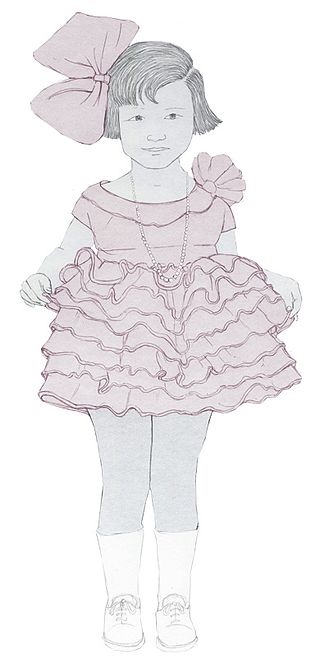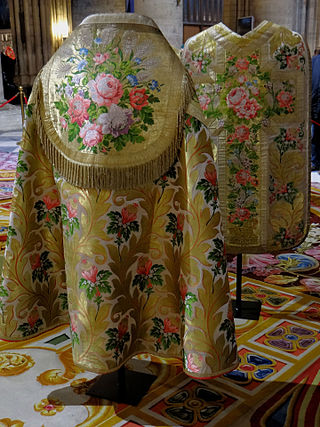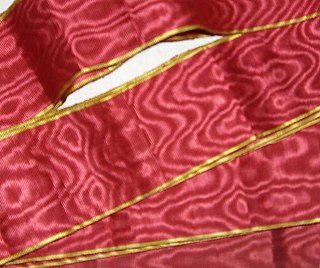Related Research Articles

Textile is an umbrella term that includes various fiber-based materials, including fibers, yarns, filaments, threads, different fabric types, etc. At first, the word "textiles" only referred to woven fabrics. However, weaving is not the only manufacturing method, and many other methods were later developed to form textile structures based on their intended use. Knitting and non-woven are other popular types of fabric manufacturing. In the contemporary world, textiles satisfy the material needs for versatile applications, from simple daily clothing to bulletproof jackets, spacesuits, and doctor's gowns.

Poplin, also called tabinet, is a fine wool, cotton or silk fabric that has a vertical warp and a horizontal weft. Nowadays, the name refers to a strong material in a plain weave of any fiber or blend, with crosswise ribs that typically give a corded surface.
Lawn cloth or lawn is a fine plain weave textile, made with fine combed cotton. Terms also used include batiste and nainsook. Originally the name applied to plain weave linen, and linen lawn is also called "handkerchief linen". The term lawn is also used in the textile industry to refer to a type of starched crisp finish given to a cloth product. The finish can be applied to a variety of fine fabrics, prints or plain.
Calendering of textiles is a finishing process used to smooth, coat, or thin a material. With textiles, fabric is passed between calender rollers at high temperatures and pressures. Calendering is used on fabrics such as moire to produce its watered effect and also on cambric and some types of sateens.

Ninon is a lightweight, sheer fabric made with plain or leno weaving, it is a suitable material for curtains, evening wear and lingerie. Ninon is made with variety of filament yarns such as polyester, silk, rayon or nylon.
Dowlas was a strong coarse linen cloth of the 16th and 17th centuries, and initially, it was manufactured in Brittany. In the 18th century the fabric was also produced in England and Scotland. Dowlas was identical to sailcloth. The cloth was also imitated in cotton for the same use.

An antependium, also known as a pulpit fall, parament or hanging, or, when speaking specifically of the hanging for the altar, an altar frontal, is a decorative piece, usually of textile, but also metalwork, stone or other material that can adorn a Christian altar.
Sendal, cendal or sandal is a thin and light silk material, chiefly used to make ceremonial clothing, church vestments, and banners. The word derives from Greek σινδων (sindōn), "fine linen"; the old French word is cendal. The word often describes a fabric woven of a linen warp and a silk weft.
Zephyr or zephyr cloth is a sheer, lightweight cotton fabric, usually plain woven, used for dresses, blouses, and shirts. It may be striped or checked. It is named after Zephyr, the Greek god of the west wind.

Broadcloth is a dense, plain woven cloth, historically made of wool. The defining characteristic of broadcloth is not its finished width but the fact that it was woven much wider and then heavily milled in order to shrink it to the required width. The effect of the milling process is to draw the yarns much closer together than could be achieved in the loom and allow the individual fibres of the wool to bind together in a felting process, which results in a dense, blind face cloth with a stiff drape which is highly weather-resistant, hard wearing and capable of taking a cut edge without the need for being hemmed.

Organdy, also spelled Organdie, is a kind of sheer fabric. It is a lightweight balanced plain weave cotton with features of sheerness and crispness.

Brocade is a class of richly decorative shuttle-woven fabrics, often made in coloured silks and sometimes with gold and silver threads. The name, related to the same root as the word "broccoli", comes from Italian broccato meaning "embossed cloth", originally past participle of the verb broccare "to stud, set with nails", from brocco, "small nail", from Latin broccus, "projecting, pointed".

Goldwork is the art of embroidery using metal threads. It is particularly prized for the way light plays on it. The term "goldwork" is used even when the threads are imitation gold, silver, or copper. The metal wires used to make the threads have never been entirely gold; they have always been gold-coated silver or cheaper metals, and even then the "gold" often contains a very low percent of real gold. Most metal threads are available in silver and sometimes copper as well as gold; some are available in colors as well.

Herringbone, also called broken twill weave, describes a distinctive V-shaped weaving pattern usually found in twill fabric. It is distinguished from a plain chevron by the break at reversal, which makes it resemble a broken zigzag. The pattern is called herringbone because it resembles the skeleton of a herring fish. Herringbone-patterned fabric is usually wool, and is one of the most popular cloths used for suits and outerwear. Tweed cloth is often woven with a herringbone pattern.

Moire, less often moiré, is a textile with a wavy (watered) appearance produced mainly from silk, but also wool, cotton and rayon. The watered appearance is usually created by the finishing technique called calendering. Moiré effects are also achieved by certain weaves, such as varying the tension in the warp and weft of the weave. Silk treated in this way is sometimes called watered silk.
Ailesham cloth was a fine linen cloth made in England during Middle Ages.
Momie cloth is a pebble-surfaced crêpe structure made of any natural or synthetic yarns. Momie crepe is a light weight material made of cotton.
Seerhand muslin (Seerhand) was a plain weave thin cotton fabric produced in the Indian subcontinent.
Bure was an old heavy woolen woven cloth that has undergone many changes since the Middle Ages. Hence, It was called with many names such as Bura, Burel, Burian, Burly, Burlesque, Burratto, Bournous, Burratine.
Faille is a type of cloth with flat ribs, often made in silk. It has a softer texture than grosgrain, with heavier and wider cords or ribs. Weft yarns are heavier than warp, and it is manufactured in plain weaving. It was especially popular in the 19th century.
References
- ↑ Rock, Daniel (1876). Textile Fabrics. Committee of Council on Education. p. 70.
- ↑ Fairchild's dictionary of textiles. Internet Archive. New York, Fairchild Publications. 1959. p. 4.
{{cite book}}: CS1 maint: others (link) - ↑ Rock, Daniel (1870). South Kensington Museum. Textile Fabrics; a Descriptive Catalogue of the Collection of Church Vestments, Dresses, (etc.) Forming Stat Section of the Museum. Chapman. pp. LXXXIII.
- ↑ Hill, Georgiana (1893). A History of English Dress from the Saxon Period to the Present Day. R. Bentley. p. 101.